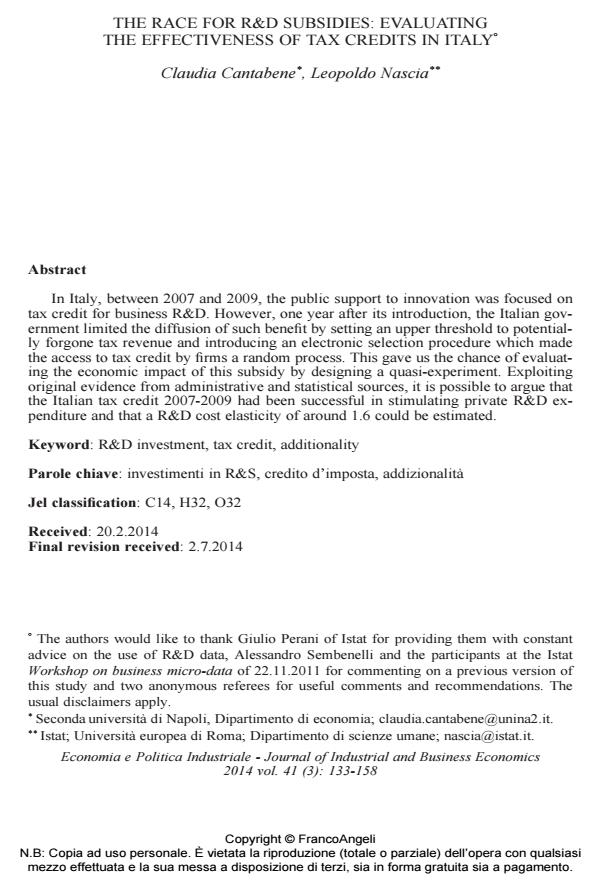The race for R&D subsidies: evaluating the effectiveness of tax credits in Italy
Titolo Rivista ECONOMIA E POLITICA INDUSTRIALE
Autori/Curatori Claudia Cantabene, Leopoldo Nascia
Anno di pubblicazione 2014 Fascicolo 2014/3
Lingua Italiano Numero pagine 26 P. 133-158 Dimensione file 122 KB
DOI 10.3280/POLI2014-003006
Il DOI è il codice a barre della proprietà intellettuale: per saperne di più
clicca qui
Qui sotto puoi vedere in anteprima la prima pagina di questo articolo.
Se questo articolo ti interessa, lo puoi acquistare (e scaricare in formato pdf) seguendo le facili indicazioni per acquistare il download credit. Acquista Download Credits per scaricare questo Articolo in formato PDF

FrancoAngeli è membro della Publishers International Linking Association, Inc (PILA)associazione indipendente e non profit per facilitare (attraverso i servizi tecnologici implementati da CrossRef.org) l’accesso degli studiosi ai contenuti digitali nelle pubblicazioni professionali e scientifiche
In Italy, between 2007 and 2009, the public support to innovation was focused on tax credit for business R&D. However, one year after its introduction, the Italian government limited the diffusion of such benefit by setting an upper threshold to potentially forgone tax revenue and introducing an electronic selection procedure which made the access to tax credit by firms a random process. This gave us the chance of evaluating the economic impact of this subsidy by designing a quasi-experiment. Exploiting original evidence from administrative and statistical sources, it is possible to argue that the Italian tax credit 2007-2009 had been successful in stimulating private R&D expenditure and that a R&D cost elasticity of around 1.6 could be estimated.
Parole chiave:Investimenti in R&S, credito d’imposta, addizionalità
Jel codes:C14, H32, O32
- The intensity of business R&D in Italy: why reducing the gap with the EU is possible and worthwhile Alessandro Sterlacchini, in Economia e Politica Industriale /2017 pp.245
DOI: 10.1007/s40812-016-0068-z - R&D tax incentives in EU countries: does the impact vary with firm size? Alessandro Sterlacchini, Francesco Venturini, in Small Business Economics /2019 pp.687
DOI: 10.1007/s11187-018-0074-9 - How Does the Evolution of R&D Tax Incentives Schemes Impact Their Effectiveness? Evidence From a Meta-Analysis Florence Blandinières, Daniela Steinbrenner, in SSRN Electronic Journal /2021
DOI: 10.2139/ssrn.3805605 - Effectiveness of R&D subsidies during the crisis: firm-level evidence across EU countries David Aristei, Alessandro Sterlacchini, Francesco Venturini, in Economics of Innovation and New Technology /2017 pp.554
DOI: 10.1080/10438599.2016.1249543 - Liquidity and Firms’ Response to Fiscal Stimulus Antonio Acconcia, Claudia Cantabene, in The Economic Journal /2018 pp.1759
DOI: 10.1111/ecoj.12499 - The interconnection between fiscal policy and foreign direct investment with R&D: Insights from East Asian countries Sadik Aden Dirir, in Upravlenets /2023 pp.15
DOI: 10.29141/2218-5003-2023-14-4-2
Claudia Cantabene, Leopoldo Nascia, The race for R&D subsidies: evaluating the effectiveness of tax credits in Italy in "ECONOMIA E POLITICA INDUSTRIALE " 3/2014, pp 133-158, DOI: 10.3280/POLI2014-003006